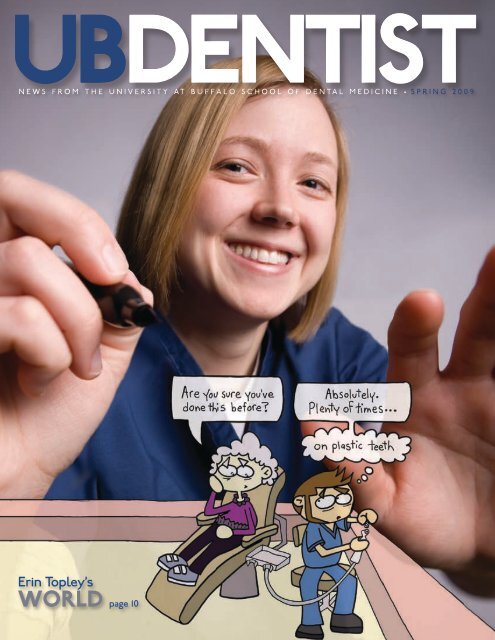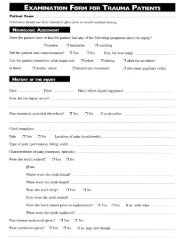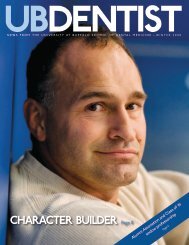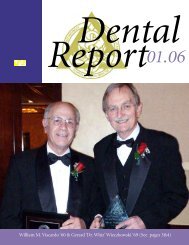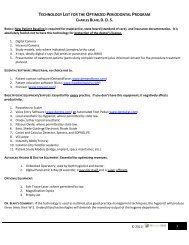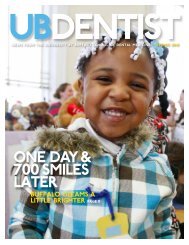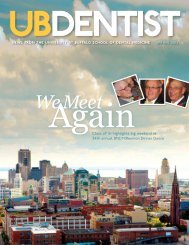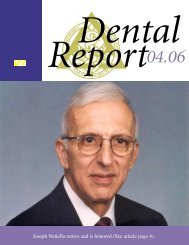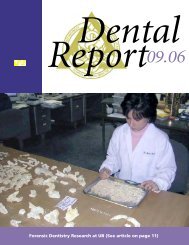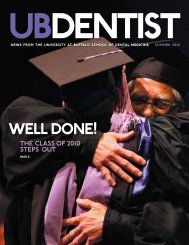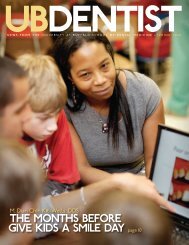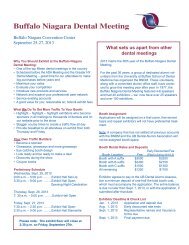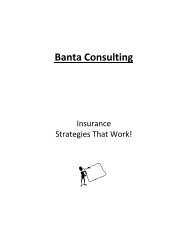Create successful ePaper yourself
Turn your PDF publications into a flip-book with our unique Google optimized e-Paper software.
<strong><strong>UB</strong>Dentist</strong><br />
nEws from ThE univErsiTy aT buffalo school of dEnTal mEdicinE u <strong><strong>UB</strong>Dentist</strong><br />
spring 2009<br />
Erin Topley’s<br />
world page 10
In the winter issue of <strong>UB</strong> Dentist, I touched on our plans for renewal in<br />
the school’s clinical education facilities. Now I’d like to tell you about our<br />
progress in this effort in more detail.<br />
We are moving forward where we can despite the uncertain financial<br />
climate. We had earlier purchased and deployed new operator chairs for<br />
all operatories in the clinics. We have also completed cabling for digital<br />
radiography and to support point-of-service digital imaging for all clinic<br />
operatories. This will also support the point-of-care delivery of our electronic<br />
oral health record this fall.<br />
We do not need to make major architectural changes in our clinics: we<br />
have nicely located clinical spaces in a building that has been well cared<br />
for. The key piece of our clinic renovation—and the most costly—is replacing<br />
all the equipment in the clinics, including patient treatment chairs and<br />
the associated equipment and cabinetry.<br />
New operatories will support more contemporary practices in infection<br />
control, which will make us somewhat more efficient. The new clinical<br />
equipment will also enable us to incorporate simulation directly into clini-<br />
from the<br />
dean<br />
cal education settings, facilitating the transition of second-year students<br />
into third-year clinical experience. This is a major potential benefit as it<br />
will move our novice clinicians off the flat<br />
part of the clinical learning curve much<br />
more rapidly, enhancing their clinical<br />
productivity, better preparing them for<br />
independent clinical practice while enhancing<br />
our capacity to serve.<br />
We hope to have completed the renovations by acquiring new operatories<br />
within the next two years. To do so, we will commit our own resources,<br />
obtain funding from the university, and seek funds from friends and industry<br />
partners. It is possible that the federal American Recovery and Reinvestment<br />
Act of 2009 will benefit our plans.<br />
Fortunately, we are in a very strong position to compete for federal economic<br />
stimulus funds, especially in the Health Information Technology<br />
category due to our extensive previous work in this area and the conspicuous<br />
strength of our IT group.<br />
We are attempting to confirm all sources of support so that the final clinical<br />
renewal plan can be approved this summer.<br />
In the next issue of <strong>UB</strong> Dentist, I hope to be able to report to you the actual<br />
implementation schedule for what is the school’s most important facilities<br />
improvement project in more than two decades.<br />
Richard N. Buchanan, DMD
<strong><strong>UB</strong>Dentist</strong><br />
news from the university at buffalo<br />
school of dental medicine<br />
<strong>UB</strong> Dentist is published quarterly<br />
by the School of <strong>Dental</strong> Medicine;<br />
produced by the Newsletters Unit<br />
of the Office of University Communications,<br />
Division of External<br />
Affairs. Spring 2009. 09-DEN-001<br />
www.sdm.buffalo.edu<br />
SDM EDitorial Group<br />
Pamela C. Jones, PhD<br />
Assistant Dean and CFO<br />
School of <strong>Dental</strong> Medicine<br />
Marilyn I. Sulzbach<br />
Executive Secretary<br />
<strong>UB</strong> <strong>Dental</strong> <strong>Alumni</strong> Association<br />
NEwSlEttErS uNit<br />
Judson Mead<br />
Newsletters Coordinator<br />
Lauren Newkirk Maynard<br />
Newsletters Editor<br />
Cynthia Todd-Flick<br />
Production Coordinator<br />
Celine Tan<br />
Art Director and Designer<br />
Cover Photo: Douglas Levere<br />
<strong>UB</strong> <strong>Dental</strong> <strong>Alumni</strong> Association<br />
337 Squire Hall<br />
Buffalo, NY 14214-8006<br />
800-756-0328, ext. 2<br />
(716) 829-2061<br />
Fax: (716) 829-3609<br />
msulzbac@buffalo.edu<br />
www.ubdentalalumni.org<br />
in<br />
this<br />
issUe<br />
2nEws briEfs<br />
}<br />
}<br />
}<br />
Dean search begun<br />
A taste of India<br />
Kids get their smiles<br />
8alTogEThEr<br />
digiTal<br />
School builds its own<br />
electronic record systen<br />
6 ThE quiET clinic<br />
Postgraduate training in orthodontics is a happy place to be<br />
10 wry looks<br />
Erin Topley, ‘09, has fun with dental school<br />
12 rEsEarch nEws<br />
Swap the needle for nasal spray?<br />
13 convErsaTion: John crawford<br />
New director of development talks about his role<br />
14 building ThE school<br />
Charitable gift annuities are an effective way to give<br />
16 class noTEs<br />
spring 2009<br />
nEws<br />
The sad duty of Ray<br />
Miller<br />
15alumni<br />
publicaTion of ub dEnTisT is madE possiblE by ThE<br />
gEnErous supporT of ThE univErsiTy aT buffalo<br />
dEnTal alumni associaTion.
Jason chwirut<br />
newsbriefs<br />
William Feagans<br />
1927-2009<br />
Dean Emeritus William<br />
Feagans died on April 5,<br />
2009, at his home in Palm<br />
Beach Gardens, Fla. after<br />
a long illness. The School<br />
of <strong>Dental</strong> Medicine held<br />
a service memorializing<br />
his 23-year tenure as dean<br />
on April 24. Dean Feagans’<br />
family suggests that<br />
contribution in his memory<br />
by made to the dental<br />
school’s William M. Feagans<br />
Endowerd Professorship or<br />
to Hospice of Palm Beach<br />
County.<br />
Heading to Women and Children’s<br />
Hospital, together, are (left to right)<br />
Andrew Beuttenmuller, Amy Stone,<br />
Carrie Wanamaker and Adam Shepherd.<br />
See story 2, this page.<br />
2 u <strong><strong>UB</strong>Dentist</strong> spring 2009<br />
1<br />
dental<br />
A national search for<br />
school dean<br />
search announced<br />
the dean of the <strong>UB</strong> School of<br />
<strong>Dental</strong> Medicine has begun.<br />
“<strong>UB</strong> will recruit an individual<br />
with stellar academic<br />
credentials who will lead the<br />
ongoing initiatives of the faculty<br />
of the school to move its<br />
programs into the top tier,”<br />
said David L. Dunn, MD,<br />
PhD, vice president for health<br />
sciences, who announced the<br />
membership of the committee<br />
that will conduct the search.<br />
Robert J. Genco, SUNY<br />
Distinguished Professor, will<br />
chair the committee.<br />
“I am sure we will attract<br />
a large number of excellent<br />
candidates, and I look<br />
forward to the committee’s<br />
recommendations,” Dunn<br />
said.<br />
In addition to Genco, the following<br />
individuals will sit on<br />
the search committee:<br />
Mark C. Barabas, president<br />
and chief operating officer,<br />
Erie County Medical Center<br />
Frank C. Barnashuk, pastpresident,<br />
Eighth District<br />
<strong>Dental</strong> Society, postdoctoral<br />
program director for general<br />
dentistry and assistant professor<br />
of restorative dentistry,<br />
School of <strong>Dental</strong> Medicine<br />
Joseph E. Bernat, chair,<br />
postdoctoral program director<br />
and clinical associate<br />
professor in the Department<br />
of Pediatric and Community<br />
Dentistry, and associate dean<br />
for government and hospital<br />
affairs, School of <strong>Dental</strong><br />
Medicine<br />
Mary A. Bisson, professor of<br />
biological sciences, College of<br />
Arts and Sciences<br />
Barry C. Boyd, clinical associate<br />
professor of oral and<br />
maxillofacial surgery, School<br />
of <strong>Dental</strong> Medicine<br />
Gayle A. Brazeau, associate<br />
dean of curricular affairs and<br />
associate professor, School of<br />
Pharmacy and Pharmaceutical<br />
Sciences<br />
Linda Caley, assistant professor,<br />
School of Nursing<br />
Heidi Crow, assistant dean<br />
for postdoctoral general dentistry<br />
and associate professor<br />
of oral diagnostic sciences,<br />
School of <strong>Dental</strong> Medicine<br />
Michael Duffey, professor<br />
of physiology and biophysics,<br />
School of Medicine and<br />
Biomedical Sciences<br />
Jude Fabiano, associate<br />
dean for clinical affairs and<br />
clinical associate professor of<br />
restorative dentistry, School<br />
of <strong>Dental</strong> Medicine<br />
Jo L. Freudenheim, <strong>UB</strong><br />
Distinguished Professor and<br />
chair, Department of Social<br />
and Preventive Medicine,<br />
School of Public Health and<br />
Health Professions<br />
Robert G. Hoeing, associate<br />
professor of linguistics,<br />
College of Arts and Sciences;<br />
chair of the Faculty Senate<br />
Chunhao (Chris) Li, assistant<br />
professor of oral biology,<br />
School of <strong>Dental</strong> Medicine<br />
Richard J. Lynch, executive<br />
council member, <strong>UB</strong> <strong>Dental</strong><br />
<strong>Alumni</strong> Association<br />
Eugene A. Pantera Jr., assistant<br />
dean for continuing<br />
education and clinical assistant<br />
professor of periodontics<br />
and endodontics, School of<br />
<strong>Dental</strong> Medicine<br />
Maureen Sullivan-Nasca,<br />
chief, Department of Dentistry<br />
and Maxillofacial Prosthetics,<br />
Roswell Park Cancer<br />
Institute<br />
Lawrence Zielinski, president,<br />
Buffalo General Hospital,<br />
Kaleida Health Systems<br />
2<br />
The final four<br />
“We should have<br />
bought a lotto ticket,”<br />
jokes Amy Stone, one of four<br />
students heading to Women<br />
and Children’s Hospital of<br />
Buffalo this year to specialize<br />
in pediatric dentistry.<br />
It’s the first time in recent<br />
memory that all residency<br />
matches at the hospital are<br />
to <strong>UB</strong> students. The chosen<br />
four participated in the School<br />
of <strong>Dental</strong> Medicine’s Match<br />
Day lunch on January 26,<br />
when students and faculty<br />
celebrated the Class of 2009’s<br />
postdoctoral placements.<br />
Stone and classmates Andrew<br />
Beuttenmuller, Adam Shep-
herd and Carrie Wanamaker<br />
spent many hours together in<br />
class and in the pediatric clinics<br />
and look forward to starting<br />
their careers in Buffalo.<br />
“We took the pediatric lit<br />
review together, and it was a<br />
small class of 12,” Wanamaker<br />
says. “So it’s pretty cool<br />
that four of the 12 of us are<br />
matched at the same place.”<br />
In preparation for their<br />
residency, she and Stone<br />
spent two and a half weeks at<br />
Children’s shadowing dentists,<br />
doing dentistry and observing<br />
procedures in the operating<br />
room. “You definitely bond<br />
when you’re working at the<br />
hospital together at 6 a.m.,”<br />
Wanamaker says.<br />
All four students also look<br />
forward to getting out of the<br />
classroom and into a realworld<br />
dental setting where<br />
they have more freedom and<br />
independence. “There’s a<br />
strong program at Children’s,”<br />
says Shepherd. “I want to<br />
learn from it, and become an<br />
efficient clinician.”<br />
The students will be joined<br />
at Women and Children’s<br />
Hospital by SDM alumna<br />
Jessica Levy, DDS ’08, who<br />
is in the middle of a general<br />
practice residency program at<br />
New York Medical College,<br />
Westchester Medical Center in<br />
Valhalla, N.Y.<br />
While not all 84 of SDM’s<br />
seniors participated in the<br />
match, the lunch provided<br />
an opportunity<br />
for the entire class<br />
to share the news<br />
of what they will<br />
be doing next year.<br />
Of those who did,<br />
the vast majority<br />
will be completing<br />
general practice<br />
residencies or<br />
advanced education<br />
in general<br />
dentistry programs.<br />
About<br />
10 students will be going into<br />
specialty programs, including<br />
pediatric dentistry, oral<br />
surgery and orthodontics, and<br />
a similar number have chosen<br />
to go directly into private<br />
practice.<br />
3 2009<br />
student<br />
research day<br />
<strong>Dental</strong> students,<br />
graduate and clinical postgraduate<br />
students, a postdoctoral<br />
student, one undergraduate<br />
SDM student and several<br />
postdoctoral researchers<br />
presented research projects<br />
at the 2009 <strong>Dental</strong> Student<br />
Research Day on March 5.<br />
There were 47 presentations<br />
in all. The event was sponsored<br />
by Ivoclar Vivadent.<br />
“We are grateful for support<br />
from Ivoclar for the 2009<br />
Student Research Day,” says<br />
Anne Meyer, associate dean<br />
for research at the dental<br />
conTinuEd nExT pagE u<br />
a world of TalEnT<br />
A contingent of eight dental students interested in various<br />
forms of Indian dance performed a fusion of classical dance<br />
from North India (Kathak) and South India (Bharatnatyam),<br />
Bollywood and folk traditions at the School of <strong>Dental</strong> Medicine<br />
Talent Show on Jan. 23 at the <strong>UB</strong> Center for the Arts.<br />
In the picture above, Lord Krishna (Tina Chacko, class of 2012),<br />
left, and his principal consort, Radha (Shweta Vora, class of<br />
2012), are part of a tableau representing worship in a temple<br />
devoted to the two. Vora, who choreographed the dance, is a<br />
seasoned performer with 10 years of professional dance and<br />
choreography experience, including appearances in seven<br />
Bollywood movies. Move over, Slumdog Millionaire.<br />
RestoRative in public eye<br />
Seungyee (Nina) Kim-Pusateri, DDS ’02, MS’ 05, assistant professor<br />
of restorative dentistry, published “Reliability and Accuracy of<br />
Four <strong>Dental</strong> Shade-Matching Devices” in March 2009 issue of the<br />
Journal of Prosthetic Dentistry.<br />
Namrata Nayyar, BDS, MS, a resident in the postgraduate prosthodontics<br />
program, won second place in the Graduate Prosthodontic<br />
Table Clinic Competition at the 81st annual meeting of the American<br />
Prosthodontic Society in Chicago this February.<br />
<strong><strong>UB</strong>Dentist</strong> spring 2009 u 3
newsbriefs<br />
conTinuEd<br />
OKU elects new<br />
members<br />
Gerard Wieczkowski Jr.,<br />
DDS, secretary/treasurer of<br />
Lambda Lambda Chapter,<br />
Omikron Kappa Upsilon,<br />
the National <strong>Dental</strong> Honor<br />
Society, announces that the<br />
following members of the<br />
Class of 2009 have been<br />
elected into membership in<br />
the society:<br />
Patrick Battista<br />
Jason Berk<br />
Andrew Beuttenmuller<br />
Lester Domingo<br />
Geoffrey Duviner<br />
Stacy Hoffman<br />
Jill Leiderman<br />
Xuewie (Serene) Li<br />
Seung Bum Lim<br />
Adam Shepard<br />
Michael Swirsky<br />
Also: Yoly Gonzalez, DDS, of<br />
the Department of Oral Diagnostic<br />
Sciences has been<br />
elected into faculty membership<br />
of OKU, and Anne<br />
Meyer, PhD, of the Department<br />
of Oral Diagnostic<br />
Sciences has been elected<br />
into honorary membership<br />
of OKU.<br />
4 u <strong><strong>UB</strong>Dentist</strong> spring 2009<br />
school. “The event was wellattended<br />
by dental students<br />
and faculty, and it was great<br />
to see and hear the buzz<br />
around the posters during the<br />
judging and public viewing<br />
portion of the program.”<br />
The projects ranged from<br />
very basic science—genes<br />
involved in dental infections<br />
and the sheer bond strengths<br />
of self-adhesive cements—to<br />
more clinical concerns, such<br />
as whether having a parent in<br />
the dental examination room<br />
lessens a child’s anxiety.<br />
Approximately 40 faculty<br />
members with research interests<br />
in the basic and dental<br />
clinical sciences also participated<br />
in the student research<br />
program.<br />
The SDM Student Research<br />
Group presented the annual<br />
Society for Advancement of<br />
Science Award to Anne E.<br />
Meyer, associate dean for<br />
research. The award is given<br />
annually to recognize an individual<br />
who supports dental<br />
student research at <strong>UB</strong>.<br />
Gerard Kugel, DMD, MS,<br />
PhD, associate dean for<br />
research and professor of<br />
prosthodontics and operative<br />
dentistry at Tufts University<br />
School of <strong>Dental</strong> Medicine,<br />
gave the keynote presentation.<br />
“Who Cares About<br />
Research?” Kugel spent the<br />
next day in Squire Hall meeting<br />
with groups of faculty<br />
and students.<br />
The following students received<br />
honors:<br />
Martin Smallridge, undergraduate<br />
program, mentored<br />
by Karuna Sharma, and<br />
Tobias Boehm, postgraduate<br />
program, mentored by<br />
Ernesto DeNardin, both<br />
won the Maryanne Mather<br />
Clinical Research Award for<br />
“Tannerella forsythia S-layer:<br />
Solving the layer of complexity!”<br />
and “Fibrinogen has<br />
dual effect on IgG-specific<br />
antigen binding and phagocytosis,”<br />
respectively.<br />
Xuewie (Serene) Li, predoctoral<br />
program, mentored by<br />
Mira Edgerton, and Zohair<br />
Qureshi, predoctoral program,<br />
mentored by Richard<br />
Ohrbach, both won the <strong>UB</strong><br />
School of <strong>Dental</strong> Medicine<br />
Award for “Candida albicans<br />
Sho1 membrane osmosensor<br />
initiates protective response<br />
against histatin” and “Reliability<br />
of chewing performance,”<br />
respectively.<br />
Allen Ho, graduate program,<br />
mentored by Sarah Gaffen,<br />
won the Oral Biology Award<br />
for “Differential expression<br />
and protein interactions of<br />
IL-17RCDr.”<br />
Jayaleka Amarasinghe,<br />
graduate program, mentored<br />
by Frank Scannapieco, won<br />
the Robert Genco Award<br />
(supported by Sunstar Inc.)<br />
for “Characterization of<br />
novel Fur and iron-regulated<br />
sRNA regulatory mechanism<br />
involved in biofilm formation<br />
of Aggregatibacter actinomycetemcomitans.”<br />
Timothy Weibley, predoctoral<br />
program, mentored by<br />
Sarah Gaffen, won the James<br />
English Research Award for<br />
Predoctoral Students for<br />
“Inhibitory activity of interleukin-17<br />
receptor target gene<br />
regulation by the ERK and<br />
GSK3 kinase pathways.”<br />
Satyaprasad Nayak, graduate<br />
program, mentored by Robert<br />
Baier, won the James English<br />
Research Award for Advanced<br />
Education and/or MS<br />
Students for “Development of<br />
a test model for enhancement<br />
of endodontic imaging.”<br />
Heather Conti, graduate<br />
program, mentored by Sarah<br />
Gaffen, won the James English<br />
PhD Award for “Th17<br />
cells and IL-17 receptor<br />
signaling are essential for<br />
mucosal host defense against<br />
oral candidiasis.”<br />
Travel awards for predoctoral<br />
students:<br />
Thayne Gardner – ADA/<br />
Dentsply Student Clinician<br />
Nishith Patel – ADA Conference<br />
on Research<br />
Sara Caro – Hinman Student<br />
Research Symposium<br />
Eric D’Silva – Proctor &<br />
Gamble Crest Travel Fellowship,<br />
Greater New York<br />
<strong>Dental</strong> Meeting
The Squire Hall clinics welcomed 200 Head Start preschoolers,<br />
250 Buffalo public school students, and 175 other children.<br />
4nothing but<br />
smiles<br />
Students from<br />
participating Buffalo public<br />
schools and area Head<br />
Start programs, as well as a<br />
significant number of walkin<br />
patients, received free<br />
dental exams during the 7th<br />
annual Give Kids A Smile<br />
(GKAS) Day. The children<br />
also received fluoride treatments,<br />
X-rays, sealant, oral<br />
hygiene instruction and other<br />
treatment or consultations<br />
as needed, including limited<br />
restorative dental work.<br />
GKAS volunteers included<br />
more than 20 local dental<br />
health providers, as well as<br />
<strong>UB</strong> dental students, residents<br />
and faculty; students from the<br />
<strong>Dental</strong> Assistance Program<br />
at <strong>UB</strong>’s Educational Opportunity<br />
Center (EOC); social<br />
workers from <strong>UB</strong>’s CARES<br />
Program; students from the<br />
<strong>Dental</strong> Hygiene Program at<br />
Erie Community College; and<br />
students in the undergraduate<br />
Social Work Program at Buffalo<br />
State College. The event<br />
is sponsored by the American<br />
<strong>Dental</strong> Association (ADA).<br />
“We know that there are<br />
thousands of children out<br />
there who are not receiving<br />
the dental care that they<br />
need,” says M. Dian Chin<br />
Kit-Wells, clinical assistant<br />
professor of pediatric and<br />
community dentistry and<br />
director of GKAS. “We’re so<br />
pleased the ADA would create<br />
a day where we can open<br />
up the doors of the dental<br />
school to provide access to<br />
care, and make parents more<br />
aware of dental needs early in<br />
a child’s life.”<br />
At the University at Buffalo, our purpose—our<br />
promise—is to reach others. It’s a promise that<br />
knows no boundaries.<br />
www.buffalo.edu/reachingothers<br />
Jason chwirut<br />
Think spring for cde<br />
pracTical oral mEdicinE<br />
applicaTions<br />
Interactions affecting oral cancer risk<br />
Your role in smoking cessation<br />
Common oral mucosal abnormalities, systemic diseases<br />
Impact of modern technology on oral medicine<br />
9 a.m. – 4 p.m., Friday, May 29, 2009<br />
<strong>UB</strong> School of <strong>Dental</strong> Medicine<br />
<strong>UB</strong> <strong>Dental</strong> <strong>Alumni</strong> Dentist $195<br />
Nonmember Dentist/Doctor $225 Team Member $95<br />
EducaTion on locaTion<br />
<strong>Dental</strong> Pharmacology Update: Drug<br />
Interactions and Medical Emergencies<br />
in Dentistry<br />
High Peaks Resort, Lake Placid, N.Y.<br />
8:30 a.m. – 4:30 p.m., Friday, June 5, 2009<br />
<strong>UB</strong> <strong>Dental</strong> <strong>Alumni</strong> Dentist $195<br />
Nonmember Dentist/Doctor $225 Team Member $95<br />
30Th annual chauTauqua<br />
dEnTal congrEss JULY 1-3, 2009<br />
WEDNESDAY, JULY 1<br />
Cankers, Chancres and Cancers! an update<br />
on oral ulcers<br />
Stuart L. Fischman, professor emeritus, Department of<br />
Oral Diagnostic Sciences<br />
THURSDAY JULY 2<br />
New products and procedures that Make Sense<br />
Donald E. Antonson, clinical professor and associate chair,<br />
Department of Restorative Dentistry<br />
FRIDAY, JULY 3<br />
pearls in <strong>Dental</strong> therapeutics<br />
Sebastian G. Ciancio, professor and chair, Department of<br />
Periodontics and Endodontics<br />
12 ce hrs. avail AdA/cerp<br />
TUITION<br />
Dentist $195/3 days or $85/day<br />
<strong>Dental</strong> Team Member $95/3 days or $45/day<br />
See “Travel Programs” at www.buffaloce.org<br />
for full details.<br />
complete course details & online registration:<br />
www.Buffaloce.org<br />
(716) 829-2320<br />
<strong><strong>UB</strong>Dentist</strong> spring 2009 u 5
the first<br />
specialty<br />
there is a quiet realm in the<br />
southwest corner of the first<br />
floor of Squire Hall where<br />
some 20 mostly young dentists practice<br />
in a bright clinic of their own. They are<br />
orthodontists in the making, residents in<br />
the School of <strong>Dental</strong> Medicine’s oldest<br />
postgraduate program—started in<br />
1947—learning dentistry’s original certified<br />
specialty.<br />
The program admits six students a year,<br />
among them always one international<br />
student and usually one into a PhD<br />
track. Fellows come and go, rounding<br />
out the clinical headcount. The residents<br />
are organized in five teams that practice<br />
together in pastel color-coded sections<br />
of the clinic. The ambient sound in<br />
the clinic is an unpunctuated murmur<br />
of conversation, between doctor and<br />
patient, doctor and doctor, and doctor<br />
and faculty.<br />
Paul Ziarnowski, ’77, Ortho ’82, is one<br />
of the faculty members in that rolling<br />
conversation, moving from chair to<br />
chair. A clinical assistant professor with<br />
a practice in Springville, N.Y., he teaches<br />
two days a week. “I learn as much as I<br />
give,” he says, surveying the clinic. “I<br />
learn every day here.” He sits down at a<br />
patient chair and pulls on gloves and a<br />
mask to take a close look at something a<br />
resident wants his opinion about.<br />
The Department of Orthodontics has<br />
four full-time, three part-time clinical<br />
and several volunteer clinical faculty.<br />
Full-time faculty members teach two<br />
6 u <strong><strong>UB</strong>Dentist</strong> spring 2009<br />
days a week and pursue research two<br />
days a week; the part-time faculty teach<br />
one or two days a week.<br />
Department chair C. Brian Preston came<br />
to <strong>UB</strong> 13 years ago after serving for 12<br />
years as dean of the University of Witswatersrand<br />
dental school in Johannesburg,<br />
South Africa, where, as part of a<br />
dental-medical complex, his students had<br />
close contact with medical students—<br />
a model which he believes has some<br />
benefits. He is an active researcher and a<br />
world figure in orthodontics; his lecture<br />
itinerary this spring includes Australia,<br />
Europe, Japan, South Africa and several<br />
Middle East countries.<br />
Assistant professor Guoqiang Guan, Ortho<br />
’08, who joined the faculty in 2008,<br />
has had a career as far-flung as Preston’s<br />
lecture travels. He earned a DDS from<br />
Peking University, a PhD and a certificate<br />
in orthodontics from Okayama University<br />
in Japan, spent four years as a senior<br />
biomedical sciences research associate<br />
at Baylor College of Dentistry where he<br />
completed a fellowship in craniofacial<br />
biology, and then completed the certificate<br />
program in orthodontics at <strong>UB</strong>.<br />
The other relative newcomer to the<br />
faculty, but not to the dental school, is<br />
Sawsan Tabbaa, MS ’97, Ortho ’04, who<br />
joined the department in 2007 as an assistant<br />
professor. She earned a DDS and<br />
a certificate in orthodontics at Damascus<br />
University in Syria, completed a residency<br />
and an MS in TMD and orofacial<br />
pain in the Department of Oral Diagnos-<br />
by Judson mead<br />
tic Sciences at <strong>UB</strong> and was a researcher<br />
at the school before completing the certificate<br />
program in orthodontics at <strong>UB</strong>.<br />
She published the Northeastern Society<br />
of Orthodontists’ case of the month in<br />
July 2008.<br />
Guan, who is the clinic director for the<br />
program, says he returned to clinical<br />
work from his research interlude at Baylor<br />
because he wanted to be equally well<br />
equipped as a teacher, a researcher and<br />
a clinician. For most things that come<br />
up for the residents, he’s just been there.<br />
“I’m familiar with what they need,” he<br />
says. When he isn’t in the clinic, he is in<br />
a lab in Foster Hall conducting stem-cell<br />
research in the area of periodontal tissue<br />
regeneration and research on inflammation<br />
in TMD.<br />
Most residents come to the program<br />
through the match system (see a related<br />
news item on Page 3)—like Michelle<br />
Stanislowsky, now in her second year,<br />
who matched from the University of<br />
Connecticut. She is from Saratoga<br />
Springs, N.Y., and an upstate New York<br />
program was what she wanted. Candidates<br />
for orthodontics programs (and<br />
for other specialties) tend to self-select<br />
before they start making out applications<br />
so that the whole pool of applicants is<br />
impressive. International applicants are a<br />
global best of the best.<br />
Waseem Kassas, also a second year<br />
resident, came to <strong>UB</strong> with a DDS and<br />
specialty training in periodontics, both<br />
from Damascus University. His father,
who practices in Damascus, came to <strong>UB</strong><br />
for implantology coursework 10 years<br />
ago. There can be no more meaningful<br />
endorsement than to encourage the son<br />
to follow.<br />
In the summer before they start the<br />
program, residents spend four weeks in<br />
what Preston calls orthodontics boot<br />
camp, an intensive training course run<br />
by Great Lakes Orthodontics at their<br />
facilities in Tonawanda. “When the<br />
residents come in, they’ve been through<br />
the wringer,” Preston says. The session<br />
gives faculty a good fix on skills levels of<br />
the incoming residents. Preston says he<br />
doesn’t know of any other department<br />
that offers this kind of jump-start.<br />
When they begin the program proper,<br />
residents get more intensive “wire bending”<br />
bench training from a specialist<br />
who comes in from Japan for six weeks.<br />
New residents work up prospective patients<br />
for about six months before they<br />
start treating cases.<br />
New patients are screened for underlying<br />
conditions that would interfere with<br />
treatment. Most patients are teenagers<br />
or pre-teens. If they and their parents<br />
agree to treatment, the work-up includes<br />
X-rays, impressions (from which digital<br />
models are rendered) and extensive photographs<br />
of teeth and face. This material<br />
is digitally mapped and manipulated and<br />
eventually collated in a portfolio that is<br />
the documentation for a treatment plan<br />
that residents and faculty work on.<br />
The program was lengthened from 30<br />
to 36 months in 2007. The curriculum<br />
and clinical training—and a written<br />
examination at the end of year two—<br />
fulfill the requirements for admission to<br />
the American Board of Orthodontics.<br />
Residents see patients three and a half<br />
days a week and spend the balance of<br />
their time on the academic curriculum,<br />
their master’s research and teaching in<br />
the DDS program.<br />
Because orthodontic treatment often<br />
lasts longer than a resident’s training,<br />
third-year residents hand off their cases<br />
to first- and second-years. This formalized<br />
process, which involves faculty, is<br />
an opportunity for collaboration, which<br />
is the pervasive spirit in the clinic.<br />
Each resident starts about 35 cases and<br />
eventually carries a patient load of about<br />
125. Stanislowsky, now halfway through<br />
the program, has appointments booked<br />
eight weeks out.<br />
When Preston characterizes the department,<br />
which he has headed long enough<br />
to leave his stamp, he says that clinically<br />
it is very technique-oriented— “I come<br />
from that background,” he says—and<br />
that it does an impressive amount of<br />
research for its size.<br />
Second-year residents<br />
Michelle Stanislowsky<br />
and Waseem Kassas with<br />
Paul Ziarnowski, clinical<br />
assistant professor, in<br />
the orthodontics clinic.<br />
<strong>Dental</strong> school dean Richard Buchanan<br />
credits Preston for the department’s<br />
significant scholarly production that he<br />
says enhances and enriches its clinical<br />
training. “The department is well recognized<br />
within the school and around the<br />
nation,” he says.<br />
The clinic is<br />
small enough “ i learn as much<br />
to be a<br />
as i give. i learn<br />
real community,<br />
one every day here.”<br />
that is both<br />
–paul Ziarnowski<br />
stable and<br />
continually renewing itself as residents<br />
enter and finish. And, Preston says, the<br />
international residents’ different cultural<br />
perspectives are a wonderful benefit.<br />
After they have finished, graduates of<br />
the program tend to scatter. “Thay<br />
have a good idea where they want to go<br />
before they come here,” Preston says. He<br />
guesses that half a dozen have stayed in<br />
the area over the past 10 years.<br />
But wherever they go, Preston holds the<br />
alumni community together with bonds<br />
of friendship and professional courtesy:<br />
he’s always ready to discuss a case. x<br />
<strong><strong>UB</strong>Dentist</strong> spring 2009 u 7<br />
kc kratt
Paper<br />
Charts<br />
no more<br />
Currently, all these<br />
functions, among<br />
many others, are<br />
supported by a hybrid system<br />
that combines paper charts<br />
and a computer-based clinic<br />
management system, known<br />
as “Picasso,” whose functions<br />
include coordinating appointments,<br />
recording student<br />
grades and billing—but little<br />
patient medical information.<br />
That’s all about to change as<br />
the <strong>UB</strong> dental school prepares<br />
to embark on an ambitious<br />
new project aimed at fully<br />
integrating electronic oral<br />
health records into its existing<br />
information technology.<br />
“This project basically touches<br />
on all of the constituents of<br />
the school; we’ve all got some<br />
clinical responsibilities,” says<br />
Gunther Kohn, chief information<br />
officer for the dental<br />
school. “It impacts all our<br />
8 u <strong><strong>UB</strong>Dentist</strong> spring 2009<br />
by kevin fryling<br />
Each year, some 55,000 patients come through the general<br />
dental clinic in the School of <strong>Dental</strong> Medicine. Supporting<br />
this very large patient population are hundreds of clinical<br />
faculty, staff, students and residents, who, depending on<br />
role, handle everything from diagnosis and treatment to appointments,<br />
patient billing and student evaluations. y<br />
mission elements too—student<br />
education, research, patient<br />
care, and community outreach.”<br />
In fact, Kohn, who is chair<br />
of the school’s electronic oral<br />
health record committee, says<br />
<strong>UB</strong> has been a longtime pioneer<br />
in electronic oral health<br />
records, noting that John<br />
Eisner, retired associate dean<br />
for information resources,<br />
developed a prototype for an<br />
electronic health record nearly<br />
20 years ago, long before such<br />
a system was on anyone’s<br />
must-have list. Now, Eisner’s<br />
early vision is closer than ever<br />
to becoming a reality.<br />
But creating and integrating<br />
a full-fledged electronic oral<br />
health record into an existing<br />
clinic management system is<br />
still an enormous challenge—<br />
and one few other dental<br />
schools are attempting. To<br />
Gunther Kohn<br />
accomplish the job, the dental<br />
school is turning to a small<br />
group of dedicated programmers<br />
in Kohn’s office, working<br />
in close collaboration with<br />
dental faculty.<br />
“We felt that the future was in<br />
the computer-based management<br />
of oral health records,<br />
and of clinics,” says former<br />
dean Louis Goldberg, discussing<br />
the decision to integrate<br />
electronic oral health records<br />
into the school’s current clinic<br />
management system, as well as<br />
the creation of the original system<br />
more than a decade ago.<br />
“Our overall goal is to develop<br />
a very high-quality, fully<br />
interoperable electronic oral<br />
health record,” says Kohn, explaining<br />
that electronic health<br />
records are not yet sufficiently<br />
interoperable—meaning that<br />
one system can’t “talk” with<br />
another—in part because stan-<br />
dard terminologies to describe<br />
the intricate medical information<br />
they contain are still being<br />
developed. “The really big<br />
payoff will only come once the<br />
dental record and the medical<br />
record are connected in such<br />
a way that they can easily exchange<br />
accurate information.”<br />
Semantic interoperability is<br />
extremely challenging. Incompatible<br />
terms across multiple<br />
records could result in miscommunications<br />
concerning<br />
treatment plans or drug interactions,<br />
for example, either of<br />
which may have very serious<br />
consequences for a patient.<br />
Because of these challenges,<br />
which are the subject of<br />
intensive work by experts<br />
across the country, Kohn says<br />
the dental school’s short-term<br />
goal is to “go paperless” in the<br />
next two to three years, with<br />
improvements and upgrades<br />
kc kratt
continuing after that initial<br />
benchmark is reached.<br />
in-house development<br />
Paper charts remain the “official<br />
record” in the clinics, he<br />
says, a scenario that sometimes<br />
creates strange situations<br />
in which patient information<br />
that has already gone digital—<br />
such as digital radiographs—is<br />
printed and inserted into paper<br />
charts. Rectifying this situation<br />
not only involves integrating<br />
patient information into<br />
the system, but also the installation<br />
of individual computer<br />
terminals at each of the clinic’s<br />
dental operatories, supplying<br />
instant point-of-care access to<br />
patient information to everyone<br />
working on a case. That<br />
project is slated for completion<br />
in the fall of 2009.<br />
“Of course, we’re not simply<br />
aiming to take our paper chart<br />
and convert it to an electronic<br />
chart,” says Kohn. “You<br />
can now do things with the<br />
electronic information you<br />
could never consider doing<br />
with paper. When we say the<br />
‘electronic chart,’ we’re really<br />
talking about a whole new<br />
concept.”<br />
For example, his group is not<br />
only interested in upgrading<br />
the clinical management<br />
system to include an electronic<br />
oral health record but also in<br />
making selected patient information<br />
accessible to dental<br />
students via mobile computing<br />
devices, such as iPhones and<br />
Blackberries.<br />
“While you’re walking to the<br />
reception area to meet your<br />
next patient, you could consult<br />
their data on your mobile<br />
device,” says Kohn, “or you<br />
might think of something<br />
while you’re walking between<br />
classes or going to lunch. Mobile<br />
computing really enables<br />
these very small, but very opportunistic,<br />
moments.”<br />
Studies have shown that electronic<br />
health records contain<br />
the most accurate patient<br />
information when they’re accessible<br />
at the point of care—<br />
and accurate information is<br />
the key to good oral health<br />
outcomes. Entering information<br />
later, after a dental exam<br />
or treatment, tends to degrade<br />
its accuracy.<br />
The ability to participate in<br />
this level of experimentation<br />
and customization was a<br />
central factor in developing an<br />
in-house electronic oral health<br />
record, says Goldberg, noting<br />
that commercial systems,<br />
which most of <strong>UB</strong>’s peers are<br />
using, are severely limited in<br />
many ways.<br />
“We feel that we can create<br />
a much higher quality<br />
implementation by developing<br />
in-house,” says Kohn.<br />
“You simply can’t innovate<br />
when you’re buying a product<br />
because commercial vendors<br />
are focused on the soft middle.<br />
They want to sell to the<br />
most customers—they’re not<br />
interested in the edges, in the<br />
interesting fringes.”<br />
One reason that the dental<br />
school wouldn’t find a good fit<br />
with a prepackaged software<br />
system, most of which are designed<br />
for small private practices,<br />
is the school’s enormous<br />
patient population. “We’re<br />
really like an outpatient<br />
hospital,” notes Goldberg,<br />
“with important teaching and<br />
research missions as well.”<br />
Kohn says an out-of-the-box<br />
electronic health record system<br />
designed for a non-teaching<br />
practice can’t handle student<br />
evaluations and grading.<br />
better patient outcomes<br />
In terms of research, Goldberg<br />
says an in-house electronic<br />
oral health record system offers<br />
even greater advantages.<br />
“If you’ve got an electronic<br />
record, then you’ve got an<br />
enormous amount of information<br />
concerning the oral health<br />
of a large number of patients,”<br />
he says.<br />
“If you’ve got the electronic<br />
health records for a large<br />
number of patients over many<br />
years you are able to use the<br />
information in those records to<br />
do a wide variety of important<br />
studies that would otherwise be<br />
very time consuming and expensive<br />
to undertake,” he says.<br />
But this can only happen with<br />
a custom-made electronic<br />
record system. Commercial<br />
products are not built to accommodate<br />
the kind of access<br />
to and manipulation of patient<br />
information necessary for<br />
research. Of course, Goldberg<br />
notes that all personal<br />
information would be stripped<br />
from an electronic record<br />
before being turned over to<br />
researchers.<br />
Perhaps the most persuasive<br />
argument in favor of<br />
the school building its own<br />
system, according to Kohn,<br />
is that studies have shown<br />
again and again that stronger,<br />
more efficient implementations<br />
of electronic health record<br />
systems result in better patient<br />
outcomes.<br />
John Eisner notes that the addition<br />
of diagnostic information<br />
to the patient record will<br />
also facilitate the collection<br />
and analysis of quality assurance<br />
data. For example, the<br />
presence of various risk factors<br />
could allow the software<br />
to alert the clinician when<br />
“ our overall goal is to develop a very<br />
high-quality, fully interoperable<br />
electronic oral health record. ”–gunther kohn<br />
contra-indicated treatment is<br />
proposed. Similarly, qualitative<br />
thresholds could be established<br />
which would allow the school<br />
(or a clinician) to measure the<br />
quality of various aspects of its<br />
patient care.<br />
“Merging the original clinic<br />
management system with an<br />
electronic health record will<br />
be a spectacular accomplishment,”<br />
says Goldberg. “And<br />
because we will have written<br />
and control the software,<br />
it will permit us to easily<br />
modify the system, to make it<br />
better, to use it for purposes<br />
we haven’t even thought of<br />
yet—and that’s an enormous<br />
advantage for everyone.” x<br />
<strong><strong>UB</strong>Dentist</strong> spring 2009 u 9
eRin<br />
topley<br />
Erin Topley, Class of 2009,<br />
sees the world from a slightly<br />
odd angle.<br />
You may remember that<br />
tumor protein 53—p53, for<br />
short—regulates the cell cycle<br />
in multicellular organisms<br />
and functions as a tumor<br />
suppressor. It’s known as<br />
the “master watchman,” or,<br />
as Erin Topley’s microbiology<br />
instructor called it, “the<br />
defender of the genome.”<br />
That’s just a line in most<br />
students’ notes, one more fact<br />
to remember. For Topley, it<br />
was bait. She went to a Halloween<br />
party as the superhero<br />
p53 Defender of the Genome.<br />
(p53 is also known as the<br />
“guardian angel of the genome,”<br />
but that’s for another<br />
Halloween.)<br />
When she isn’t catching the<br />
one-liner no one else heard,<br />
Topley is a kind of cultural<br />
anthropologist. After closely<br />
observing dental students<br />
for two years, she devised a<br />
recipe for making a dentist<br />
that calls for, among other ingredients,<br />
10 gallons of book<br />
10 u <strong><strong>UB</strong>Dentist</strong> spring 2009<br />
smarts, ½ cup street smarts<br />
and 1 tsp of people skills, 1<br />
ounce of social life and 2 tons<br />
of ego, seasoned with sexual<br />
tension.<br />
Topley is an editorial cartoonist,<br />
or, in other words, a<br />
subversive. She started poking<br />
fun at the world in the pages<br />
of her high school newspaper<br />
in Fargo, N.D. (she won<br />
a national award for her<br />
work). She took time off from<br />
wants to make<br />
cartooning when she was an<br />
undergraduate at Rochester<br />
Institute of Technology. She<br />
started again in her second<br />
year in dental school when<br />
she was about to collapse<br />
under the weight of the work.<br />
She drew caricatures next to<br />
her lectures notes. It improved<br />
her concentration.<br />
When something amused her,<br />
she’d pin it down on paper—<br />
the drawn version of stand-up<br />
comedy. Staff and students<br />
started collecting Topleys;<br />
they appeared on the walls in<br />
the dispensary and elsewhere.<br />
After a while she’d seen<br />
enough of dental school for a<br />
whole book of cartoons—so<br />
she produced a whole book<br />
of cartoons. She borrowed<br />
seed money, found a printer,<br />
wrote the text, laid out the<br />
pages and had volumes ready<br />
for sale at the 2008 Buf
you laugh<br />
falo Niagara <strong>Dental</strong> Meeting<br />
where she did good business.<br />
She says she’s not entrepreneurial<br />
at all—“I’d rather<br />
just give things away”—but<br />
she is enterprising. She found<br />
a small business advisor<br />
and set up a Web site to sell<br />
the books and individual<br />
cartoons.<br />
She branched out, cartooning<br />
for the American Student<br />
Dentist Association’s national<br />
by Judson mead<br />
newsletter—for which she<br />
was honored with a national<br />
journalism award at the<br />
ASDA annual meeting this<br />
March— and for the <strong>UB</strong><br />
student newspaper, Spectrum.<br />
She broke the gender barrier<br />
in the Buffalo <strong>Dental</strong> Bowling<br />
League, renovated a house,<br />
played hockey with the boys<br />
and was a class officer. She<br />
says she likes to keep busy.<br />
Topley was born in Winnipeg,<br />
Manitoba, where she lived<br />
until she was 12. She’s a<br />
hockey player and she<br />
got interested in dentistry<br />
only after losing<br />
two teeth playing<br />
for RIT.<br />
“I was treated over a couple<br />
of years by two wonderful<br />
young women dentists, Roxanne<br />
Lowenguth and Mary<br />
Ann Lester, and that was the<br />
first time it occurred to me<br />
that<br />
young<br />
women<br />
could be<br />
dentists,”<br />
she says.<br />
She’d thought<br />
only middle<br />
aged men<br />
could be dentists.<br />
She traded in her graphic art<br />
major for premed study. And<br />
she spread the word: Her<br />
sister, Carly, followed her into<br />
dental school (class of 2011).<br />
Erin Topley is headed for a<br />
general practice residency at<br />
a VA hospital in Minneapolis.<br />
After eight years in the East,<br />
she wants to try the upper<br />
Midwest again. She has ideas<br />
for two projects: a book for<br />
children that explains going<br />
to the dentist, and what she<br />
says would be a kind of illustrated<br />
Cliff notes for dental<br />
students.<br />
For more of Topley’s work,<br />
go to www.ToothlessToops.<br />
com. ToothlessToops? That’s<br />
another story. x<br />
<strong><strong>UB</strong>Dentist</strong> spring 2009 u 11<br />
douglas levere
esearchnews<br />
12 u <strong><strong>UB</strong>Dentist</strong> spring 2009<br />
nasal spray may End<br />
dental needle injections<br />
for upper Teeth<br />
repair<br />
A nasal spray shown to numb the<br />
upper jaw is set to be tested in<br />
an FDA Phase 3 trial, which will<br />
assess the spray’s effectiveness<br />
compared to the current “gold<br />
standard” treatment—painful<br />
anesthesia injections.<br />
“A successful trial of this new<br />
dental anesthetic will change<br />
dental technology worldwide,”<br />
says Sebastian Ciancio, DDS,<br />
SUNY Distinguished Service<br />
Professor and chair of the<br />
Department of Periodontics and<br />
Endodontics.<br />
Ciancio directed the Phase 2 trial<br />
and will coordinate the Phase 3<br />
trial. Between 6 and10 million<br />
dental needle injections are<br />
given daily, according to Ciancio.<br />
Results of the FDA Phase 2 trial,<br />
conducted in 48 subjects at the<br />
School of <strong>Dental</strong> Medicine,<br />
showed that the spray appears to<br />
be safe and effective.<br />
The Phase 3 trial will be carried<br />
out later in 2009 at the dental<br />
school and other clinical sites.<br />
Ciancio says that if the Phase 3<br />
trial is successful, it may mean<br />
the end of injections for any<br />
dental work performed on the<br />
upper teeth.<br />
Ciancio and colleagues conducted<br />
the initial preliminary<br />
dental studies using the nasal<br />
spray, which is being developed<br />
by St. Renatus, LLC, based in Fort<br />
Collins, Colo.<br />
The nasal spray formula being<br />
tested is related to a drug used<br />
by ear, nose and throat physicians<br />
when they operate on the<br />
nose. Patients who received this<br />
anesthetic reported that their<br />
upper teeth felt numb, sparking<br />
interest in using the anesthetic<br />
for dental procedures. The spray<br />
is effective only on the upper<br />
teeth.<br />
Other investigators involved in<br />
the Phase 2 and preliminary trials,<br />
all faculty from <strong>UB</strong> School of<br />
<strong>Dental</strong> Medicine, were Eugene<br />
A. Pantera, DDS; Carol T. Pantera,<br />
DDS; Fadi Ayoub, DDS; Davis<br />
Garlapo, DDS; Nina Kim, DDS;<br />
and Benita Sobierj, DDS.<br />
basis of immunity to<br />
oral Thrush, common<br />
in aids, identified by ub<br />
researchers<br />
Oral thrush, a hallmark symptom<br />
in AIDS patients, is caused<br />
by a type of yeast that grows<br />
unchecked in people with<br />
weakened immune systems, and<br />
appears in colonies of white<br />
patches in the mouth.<br />
AIDS is characterized by the<br />
progressive loss of T cells—cells<br />
that originate in the thymus and<br />
are a critical component of the<br />
immune system. A particularly<br />
important type of T cell is known<br />
as the T helper, or Th cell.<br />
Research carried out at the<br />
University at Buffalo has shown<br />
for the first time that a recently<br />
identified type of Th cell, known<br />
as Th-17, is the principal defense<br />
component required for immunity<br />
to oral thrush. Mice lacking<br />
Th-17 cells, but not other types<br />
of T cells, develop severe oral<br />
thrush.<br />
Results of the research appeared<br />
in February in the online issue<br />
of the Journal of Experimental<br />
Medicine. Heather R. Conti, PhD,<br />
a student in the Department of<br />
Oral Biology at the School of<br />
<strong>Dental</strong> Medicine, is first author.<br />
The research was conducted in<br />
the laboratory of Sarah Gaffen,<br />
formerly associate professor in<br />
the Department of Oral Biology,<br />
and in the laboratory of Mira<br />
Edgerton, DDS, PhD, research<br />
professor of oral biology. Gaffen<br />
has since left <strong>UB</strong> to take a position<br />
at the University at Pittsburgh.<br />
The research is continuing<br />
at <strong>UB</strong> under Edgerton.<br />
Additional <strong>UB</strong> contributors to the<br />
study were Fang Shen, Namrata<br />
Nayyar, Eileen Stocum, Jianing N.<br />
Sun, Matthew J. Lindemann, Allen<br />
Hoe, Justine Hoda Hai, Ji Won<br />
Jung and Patricia Masso-Welch.<br />
Scott G. Filler, from the David<br />
Geffen School of Medicine at<br />
UCLA, also was a contributor.<br />
oral biology in the<br />
$2 million-plus club<br />
Research expenditures at the<br />
University at Buffalo increased<br />
by nearly 7.7 percent to a record<br />
$348.2 million in the 2008 fiscal<br />
year.<br />
Twenty-six <strong>UB</strong> departments and<br />
centers had research expenditures<br />
exceeding $2 million in FY<br />
2008, up from 21 the previous<br />
year. One of those is the Department<br />
of Oral Biology, with<br />
total research expenditures of<br />
$2,460,242. The second highest<br />
departmental total in the dental<br />
school was $900,853 for oral<br />
diagnostic sciences.
a convErsaTion wiTh<br />
John crawford<br />
The new director of development talks about why he loves<br />
his job, and what alumni support means for the future of the<br />
dental school.<br />
Describe your development background;<br />
what does your job at the<br />
dental school entail now?<br />
I came from the School of Public<br />
Health and Health Professions<br />
(SPHHP), where I led the development<br />
efforts since 2005. Before<br />
that, I held positions as director<br />
of development for the American<br />
Red Cross, Greater Buffalo<br />
Chapter, and capital campaign<br />
coordinator for SUNY-Brockport.<br />
Now, as director of development<br />
at the School of <strong>Dental</strong> Medicine,<br />
I’m privileged to help alumni and<br />
other donors with their philanthropic<br />
investments in the school.<br />
what have your various<br />
development roles taught you?<br />
My work has made me realize<br />
how important development<br />
is to running an organization.<br />
Whether you’re talking annual<br />
funds, foundation grants, or<br />
endowment funds, my philosophy<br />
is that good philanthropic<br />
relationships are built when the<br />
vision and goals of the organization<br />
are well matched with the<br />
wishes, desires and motivation of<br />
the donor. When that happens,<br />
everybody benefits. Donors are<br />
thrilled to have made the investment,<br />
the school and university<br />
advances and our community<br />
and region are improved.<br />
what else about your job do you<br />
find fulfilling?<br />
Well, it starts at home in Western<br />
New York. It’s where I work and<br />
raise my family. I got into the<br />
business of development to help<br />
improve the community where I<br />
grew up. I started in the not-forprofit,<br />
human service sector. That’s<br />
important and rewarding work.<br />
Philanthropic investment in a research<br />
university like <strong>UB</strong>, though,<br />
can not only transform the school,<br />
but the entire community. <strong>UB</strong><br />
plays an incredibly important role<br />
in the well-being of Western New<br />
York and the region.<br />
The dental school, of course, is<br />
part of <strong>UB</strong>’s Academic Health<br />
Center, which plays a huge<br />
role in education, research and<br />
service in this region. It improves<br />
the health of both individuals<br />
and populations—a concept I<br />
embraced at the School of Public<br />
Health and Health Professions,<br />
and one that can, in some ways,<br />
be applied to the dental school.<br />
Our educational opportunities,<br />
public clinics, outreach programs<br />
in local schools and in underserved<br />
areas across the world,<br />
make it about far more than just<br />
learning dentistry.<br />
what do major gifts help fund at<br />
the dental school?<br />
Since I’ve arrived, I’ve been hugely<br />
impressed by the level of excellence<br />
here. As I travel around<br />
visiting alumni and friends of the<br />
school, I’ve also quickly witnessed<br />
the respect people have for<br />
its reputation. Generations of<br />
quality dental professionals have<br />
been trained here. It’s something<br />
to be very proud of.<br />
Now, more than ever, we need<br />
to capitalize on that reputation.<br />
The priority in my office<br />
is to help donors think big and<br />
see how they can be a part of<br />
our shared vision for the school,<br />
university, and community—to<br />
help them realize the level of<br />
gift and power of the contribution<br />
that is within their reach.<br />
Endowed chairs, for example,<br />
allow us to recruit the best<br />
faculty from around the world<br />
for our students and research<br />
endeavors. Donations to funds<br />
like these are key and the School<br />
of <strong>Dental</strong> Medicine is, perhaps,<br />
the best place in which to invest<br />
and make a difference in dental<br />
education, research and service.<br />
what role do alumni have in<br />
supporting the school?<br />
First of all, my hat’s off to the <strong>UB</strong><br />
<strong>Dental</strong> School <strong>Alumni</strong> Association.<br />
They do a terrific job donating<br />
time, talent and treasure<br />
to support the school and the<br />
profession. Clearly, development<br />
at the dental school would not<br />
be where it is today without<br />
their commitment. I would add<br />
that they also host one of the<br />
country’s best dental conventions<br />
right here in Buffalo.<br />
All of our alumni play a vital<br />
role in helping direct the dental<br />
school’s future, and there are<br />
numerous opportunities to get<br />
involved. In my office, we concentrate<br />
on providing philanthropic<br />
opportunities for alumni,<br />
“ The School of<br />
<strong>Dental</strong> Medicine is,<br />
perhaps, the best<br />
place in which to<br />
invest and make a<br />
difference in dental<br />
education, research<br />
and service.”<br />
encouraging them to stretch<br />
their giving in ways that will truly<br />
transform the school, the profession<br />
and our community.<br />
Capital renovations of SDM’s<br />
clinic facilities are our top priority<br />
and we will rely on philanthropic<br />
investment to complement other<br />
sources of revenue to renovate<br />
the clinic. Endowed chairs, professorships,<br />
research funds and<br />
scholarships are also important.<br />
These are challenging times, yet<br />
the dental school continues to<br />
produce top-notch graduates.<br />
Our alumni can provide the<br />
vision and resources to achieve<br />
our shared, long-term goals in<br />
research, education and innovation.<br />
I, along with our development<br />
staff—Marilyn Koren, Tracy<br />
Oun, Carol McCourt and Eileen<br />
Comer—look forward to working<br />
with all of our alumni and<br />
friends. Please stop by the third<br />
floor of Squire and visit us!<br />
<strong><strong>UB</strong>Dentist</strong> spring 2009 u 13<br />
kc kratt
BUilDing the sChool of <strong>Dental</strong> meDiCine<br />
a sane choice in an insane<br />
market: charitable gift annuities<br />
So here we are. As this story is written, the<br />
Dow is hovering around 7,500. Two weeks<br />
ago it was at 6,500, and when you read this,<br />
who knows where the numbers will be?<br />
One positive result of the ongoing market<br />
fluctuation is the attention that charitable<br />
gift annuities have been garnering. You may<br />
have read about them in the news as the<br />
benefits of gift annuities have been featured<br />
recently in the Wall Street Journal and<br />
Forbes.<br />
Timing is everything, and this fiscal environment<br />
may be the best time to establish a<br />
charitable gift annuity. At the very least, you<br />
owe it to yourself to explore this unique opportunity<br />
to do well and do good.<br />
A charitable gift annuity is a simple agreement<br />
between an individual and a charity<br />
(such as the University at Buffalo Foundation)<br />
in which the donor gives the charity a set<br />
amount of money. In exchange, the charity<br />
guarantees to pay the donor a fixed amount<br />
for the rest of his or her life. I know of donors<br />
who have collected annuity payments<br />
for decades—not a bad return!<br />
To sweeten the pot, donors who establish<br />
charitable gift annuities also qualify for an<br />
14 u <strong><strong>UB</strong>Dentist</strong> spring 2009<br />
immediate tax deduction to offset income<br />
taxes. This, coupled with the guaranteed,<br />
fixed, lose-no-sleep-at-night returns, often<br />
have donors coming back to establish additional<br />
gift annuities.<br />
Most charities adhere to rates recommended<br />
by the American Council on Gift Annuities.<br />
As an example, a 70-year old wishing to establish<br />
a gift annuity would earn a solid and<br />
steady 5.7 percent. Let’s say that this 70-year<br />
old wanted to establish a gift annuity with<br />
$10,000. He or she would receive $570 per<br />
year for the duration of his or her lifetime,<br />
along with a nice tax deduction in the year<br />
that the annuity is established.<br />
As an added layer of security, gift annuities<br />
are guaranteed and backed by the charity’s<br />
assets. However, you should consider the size,<br />
strength and reputation of the organization<br />
before you set up a gift annuity. A longstanding<br />
well-established group, like the<br />
University at Buffalo Foundation, then you’ll<br />
be in terrific shape.<br />
Gift annuities can come in different shapes<br />
and sizes. For example, gift annuities can be<br />
established for one or two beneficiaries. The<br />
rates will be slightly lower for two-life gift<br />
annuities, but they’re still an attractive option<br />
for couples seeking income.<br />
Individuals who are nearing but not quite<br />
ready for retirement may want to explore<br />
a deferred gift annuity. This arrangement<br />
allows a donor to set up a gift annuity now,<br />
while delaying the income until a later date.<br />
The longer a payment is deferred, the higher<br />
the rate of return. Many donors who expect<br />
to find themselves in a lower tax bracket<br />
after they retire find deferred gift annuities<br />
to be quite attractive. Another plus is the<br />
deduction that is earned immediately that<br />
helps to reduce current income taxes.<br />
And not to forget, they’re called charitable<br />
gift annuities for a reason. A portion of your<br />
contribution will be used in support of a<br />
philanthropic purpose in the future.<br />
What’s important to you when you think<br />
about supporting your alma mater through<br />
that contribution? Whatever you decide, the<br />
charitable gift annuity can make a difference<br />
in a way that fits your lifestyle. <strong>UB</strong>’s dental<br />
programs, students, faculty and staff will<br />
thank you for it!<br />
rEmEmbEr ThE school of dEnTal mEdicinE in your will<br />
Did you know that you can make a major impact on the future of the School of <strong>Dental</strong> Medicine by including us in your estate<br />
plans? Call <strong>UB</strong>’s Office of Gift Planning toll-free at 877-825-3422 to learn more about how you can support dental facilities<br />
upgrades, faculty development, curricular improvements, or student scholarships.<br />
If you plan to make a charitable gift by will, please think it through carefully. Then, meet<br />
with your attorney to discuss and update your will. Tell him or her exactly what you<br />
want to do. Be as clear as possible in describing what you want given to whom. If you<br />
prefer to remain anonymous, your gift will be kept completely confidential. But at the<br />
same time, recognition of your gift can encourage others to do the same.<br />
Thank you for your supporT!<br />
by wendy m. irving Esq.,<br />
assistant vice president for gift planning
alumninews<br />
help in a tragic moment<br />
On a bitterly cold night in February, one many<br />
Western New Yorkers remember all too well,<br />
Ray Miller, ’85, got the call.<br />
Ten minutes after Flight<br />
3407 crashed into a house in<br />
Clarence, N.Y., killing all 49<br />
people on board and one on<br />
the ground, he received his<br />
instructions: “Sit tight. We’ll<br />
need you soon”.<br />
Miller, a forensic dentist,<br />
went back to bed but rose<br />
again early the next morning<br />
to start a grueling day inspecting<br />
crash victims’ dental<br />
remains for the Erie County<br />
medical examiner’s office,<br />
based at Erie County Medical<br />
Center. As dental section<br />
chief for Flight 3407’s dental<br />
ID team, he also assessed the<br />
crash site the day after the<br />
disaster.<br />
For decades, Miller has<br />
served as a dental forensics<br />
consultant for local and<br />
federal agencies during emergency<br />
management situations<br />
like the Clarence crash. His<br />
experience includes assisting<br />
victim identification efforts<br />
after 9/11 and Katrina.<br />
Miller’s training began in dental<br />
school at <strong>UB</strong>. As a dental<br />
officer in the Air Force, he<br />
was required to take a course<br />
in forensic dentistry.<br />
Miller expresses gratitude to<br />
the local units who responded<br />
to Flight 3407. “Our team<br />
went far beyond the call of<br />
duty to uncover these victims’<br />
identities,” he says, crediting<br />
the following with assistance:<br />
SMART team members<br />
and community volunteers<br />
Donald Tucker, ’81, Peter<br />
D’Arrigo, ’71, David Millhouse,<br />
’92 and Marcia Kent;<br />
ECMC residents James<br />
Mitchener, ’88, Callie Davis,<br />
’08 and Anita Mariani ’07;<br />
ECMC attending staff Philip<br />
Williams, ’07 and Jennifer<br />
Holmer Su, ’00; and <strong>UB</strong><br />
dental faculty and staff Mary<br />
Bush, ’99 and Peter Bush.<br />
While Miller examined<br />
victims, compared records<br />
and took dental radiograph<br />
readings, Tucker was making<br />
countless calls to clinics<br />
across the country to track<br />
down corresponding dental<br />
records. His wife, Dian, and<br />
her son Brent drove all over<br />
the Southern Tier and Canada<br />
to retrieve them. A family<br />
assistance center also was set<br />
up to help victims’ families<br />
report information about<br />
their loved ones.<br />
The Clarence crash involved<br />
a relatively contained group<br />
of victims, and for the most<br />
part, their dental records have<br />
been made readily available<br />
by families and their dental<br />
offices. “We have had a few<br />
cases where parents no longer<br />
knew where their grown children<br />
currently received dental<br />
Ray Miller<br />
care and we received outdated<br />
records,” Miller says.<br />
Each emergency situation<br />
brings its own kind of chaos.<br />
The crash in Clarence happened<br />
during a particularly<br />
harsh Buffalo winter, bringing<br />
added hardship to the recovery<br />
operations. Miller says<br />
it was similar in some ways<br />
to the scene at 9/11—both<br />
involved planes crashing<br />
into structures, with fire and<br />
the fallout that resulted—<br />
by lauren n. maynard<br />
although 9/11 was “more<br />
about numbers” because<br />
of the enormous volume of<br />
remains to process. When<br />
Hurricane Katrina hit, dental<br />
records were destroyed along<br />
with entire clinics. “Every<br />
tragedy, no matter how you<br />
train, is unique,” Miller says.<br />
“You prepare for contingencies,<br />
but in the end you take<br />
it as it comes and try to be<br />
flexible.”<br />
The goal of all SDM members<br />
on the scene was to bring<br />
closure for the families, serve<br />
the crash investigation, and<br />
help everyone move on. “It’s<br />
a sociological and cultural<br />
issue—not just a medical or<br />
forensic one—for everyone<br />
involved,” Miller says.<br />
<strong><strong>UB</strong>Dentist</strong> spring 2009 u 15<br />
Jason chwirut
Class<br />
notes<br />
Michael a. Fabio, ’73, has received the Northern Virginia<br />
<strong>Dental</strong> Society Lifetime Achievement. The award was<br />
presented in recognition of his continuous leadership<br />
and service to the society, a section of the Virginia<br />
<strong>Dental</strong> Association, since he joined in 1980. In his acceptance<br />
speech, Fabio recognized William Falcone,<br />
‘54, with whom he started practice in 1978, and Bruce<br />
Seidberg, ‘63, a clinical professor in endodontics at<br />
<strong>UB</strong>, as mentors. Fabio maintains a clinical practice in<br />
endodontics in Reston and Springfield, Va. Pictured at<br />
the award ceremony are Fabio, his wife, Patricia, and<br />
their son Christopher.<br />
Greg Maurer, ‘73, has<br />
been elected as president<br />
of the<br />
Vermont<br />
State <strong>Dental</strong><br />
Society. He<br />
writes: “This<br />
is a busy year for organized<br />
dentistry as we<br />
consider changes in scope<br />
of practice for dental<br />
auxiliaries, evolving concerns<br />
about dental materials,<br />
various methods of<br />
health care delivery and<br />
the challenges for dental<br />
education.” Greg continues<br />
to maintain a general<br />
practice in Vergennes,<br />
Vt. He can be contacted<br />
through VSDS.org.<br />
Kevin J. Hanley, ’78, of<br />
Buffalo has been named<br />
editor of the New York<br />
16 u <strong><strong>UB</strong>Dentist</strong> spring 2009<br />
State <strong>Dental</strong> Journal,<br />
the clinical journal of<br />
the New<br />
York State<br />
<strong>Dental</strong> Association<br />
(NYSDA).<br />
Hanley, an orthodontist,<br />
has been an active<br />
participant in organized<br />
dentistry. He is a member<br />
of the NYSDA Board of<br />
Governors and Executive<br />
Committee. He is a past<br />
president of the Eighth<br />
District <strong>Dental</strong> Society,<br />
a component of NYSDA<br />
serving counties in Western<br />
New York. At the<br />
national level, Hanley<br />
serves as a delegate to<br />
the American <strong>Dental</strong> Association.<br />
He is active in<br />
the American Association<br />
of <strong>Dental</strong> Editors and is a<br />
member of the American<br />
College of Dentists and<br />
the International College<br />
of Dentists.<br />
richard F. andolina,<br />
’80, of Hornell, N.Y.,<br />
has been re-elected<br />
Secretary-Treasurer of<br />
the New York State<br />
<strong>Dental</strong> Association<br />
(NYSDA). Andolina, a<br />
general dentist, is a past<br />
president of the Seventh<br />
District <strong>Dental</strong> Society,<br />
a local component of<br />
NYSDA serving Rochester<br />
and the surrounding<br />
region. He was previously<br />
a member of the NYSDA<br />
Board of Governors and<br />
its Executive Committee;<br />
was chair of the NYSDA<br />
Council on <strong>Dental</strong> Practice;<br />
and served on the<br />
NYSDA Finance, Budget<br />
and Audit Committee.<br />
At the national level he<br />
has served since 2001<br />
as a delegate to the<br />
American <strong>Dental</strong> Association<br />
(ADA). Andolina is a<br />
fellow in the Academy of<br />
General Dentistry, American<br />
College of Dentists,<br />
the International College<br />
of Dentists, the Academy<br />
of Dentistry International,<br />
and the Pierre<br />
Fauchard Academy. He is<br />
a consulting dentist for<br />
several regional hospitals<br />
and has been active in his<br />
community, serving as a<br />
director on the boards of<br />
St. James Mercy Hospital,<br />
his local Chamber of<br />
Commerce, a local bank,<br />
the Humane Society and<br />
the YMCA.<br />
Bruce lieberthal, ’83, is<br />
every year a reunion year<br />
vice president of product<br />
management and development<br />
at Henry Schein<br />
Practice Solutions, where<br />
he previously served<br />
as director of product<br />
management. He has<br />
also developed, built,<br />
supported and sold multiple<br />
software platforms<br />
relevant to dentistry and<br />
endodontistry. He has 14<br />
years of experience as<br />
a practicing dentist and<br />
lives in Wrentham, Mass.<br />
Guy Ditursi, ‘86, MBA<br />
1995, has been appointed<br />
the Chief<br />
of the <strong>Dental</strong><br />
Service<br />
of the VA<br />
Western New<br />
York Healthcare System.<br />
The VA Western New<br />
York Healthcare System<br />
on fEbruary 22, 1947, the School Of <strong>Dental</strong> Medicine graduated eight den-<br />
tists from Syracuse, N.Y. For more than 50 years this group has gathered every year<br />
for a mini reunion to celebrate the occasion. This year, on the sixty-second anniversary<br />
of the day they received their degrees, John laura (left) and alfred Falcone kept<br />
the tradition alive.
includes the Buffalo and<br />
Batavia Medical Centers,<br />
and provides comprehensive<br />
dental and<br />
medical care to America’s<br />
veterans. DiTursi completed<br />
a general practice<br />
residency at the Buffalo<br />
Medical Center, and was<br />
the GPR program director<br />
prior to his appointment<br />
as the service chief.<br />
Michael E. Katz, ’88, has<br />
joined the professional<br />
staff of Western New<br />
York <strong>Dental</strong> Group. Katz<br />
completed his GPR at<br />
Roswell Park Cancer Institute<br />
and served as the<br />
director of dental medicine<br />
at Sisters of Charity<br />
Hospital of Buffalo for<br />
the past 15 years.<br />
Heidi C. Crow, MS ’91 and<br />
tMD ’91, was presented<br />
with the 2009 ADEA/<br />
Colgate Palmolive/National<br />
<strong>Dental</strong> Association<br />
Jeanne C. Sinkford<br />
Scholarship at the 86th<br />
ADEA Annual Session in<br />
Phoenix, Ariz. The Sinkford<br />
Scholarship provides<br />
the opportunity for a<br />
dental educator who is<br />
closely aligned with the<br />
promotion of equity and<br />
diversity to participate in<br />
the ADEA Leadership Institute.<br />
Crow is currently<br />
associate professor in the<br />
Department of Oral Diagnostic<br />
Sciences, assistant<br />
dean for postdoctoral<br />
dentistry programs, and<br />
program director for<br />
TMD and Orofacial Pain.<br />
Jeffrey Berkowitz, ’94,<br />
has been elected as<br />
treasurer of the Vermont<br />
State <strong>Dental</strong> Society. He<br />
has practiced dentistry<br />
with the Timberlane<br />
<strong>Dental</strong> Group in South<br />
Berlington, Vt., since<br />
1995. Berkowitz lives in<br />
Charlotte, Vt., with his<br />
wife and three young<br />
children.<br />
in memoriam<br />
Charles E. Schifley, ’44,<br />
died on Jan. 7, 2009. He<br />
practiced in South Buffalo<br />
and Lackawanna for<br />
more than 50 years.<br />
Mario J. Violante, ‘44,<br />
died on April 6, 2009 in<br />
Niagara Falls, N.Y. He was<br />
91. His son Mario J. Violante<br />
Jr., ‘76, and grandson<br />
Mario J. Violante<br />
III, ‘99, both practice in<br />
Niagara Falls.<br />
walter C. Ervin Jr., ’52,<br />
died unexpectedly on<br />
Jan. 13, 2009, at his home<br />
in Elmira, N.Y. He was 82.<br />
Ernest C. “Doc” passaretti,<br />
’53, died on Dec. 2, 2008<br />
at Albany Memorial<br />
Hospital. He was 81.<br />
robert r. Mueller, ’56,<br />
died on Jan. 29, 2009.<br />
He had a private dental<br />
practice in Greece, N.Y.<br />
for 40 years.<br />
Frederick w. Downie, ’70,<br />
died on Jan. 9, 2009. He<br />
was 64. He practiced<br />
dentistry in both the<br />
Syracuse and Albany VA<br />
hospitals.<br />
The Buffalo chapters<br />
of American student<br />
dental Association<br />
and delta sigma<br />
delta are selling T-shirts<br />
to raise funds for student activities.<br />
item #1: “I Love <strong>UB</strong> <strong>Dental</strong>”<br />
Short-sleeve, 100% pre-shrunk cotton<br />
Color: White, royal, black<br />
Size: S, M, L, XL, and XXL<br />
Price: $12 each<br />
item #2: “I Love <strong>UB</strong> <strong>Dental</strong>”<br />
Long-sleeve, 100% pre-shrunk cotton<br />
Color: white, royal, black<br />
Size: S, M, L, XL, and XXL<br />
Price: $15 each<br />
item #3: Short-sleeve, 100% preshrunk cotton<br />
Color: White, royal, black, grey, navy, red, and hunter green<br />
Size: S, M, L, XL, 2X, and 3X,<br />
Price: $12 each, 2 for $20; add $3 for 2X and 3X<br />
item #4 (not shown): Nike Dri-Fit embroidered golf polo<br />
Color: Navy with white embroidery, white with navy embroidery<br />
Size: S, M, L, XL, 2X, and 3X<br />
Price: $55 each, 2 for $100; add $5 for 2X and 3XL<br />
Order form. Orders accepted until May 30, 2009.<br />
Name:<br />
Address for delivery:<br />
For items #1 and #2 (“I Love <strong>UB</strong> <strong>Dental</strong>”), please make checks payable<br />
to to “AsdA.”<br />
For items #3 an #4 (<strong>UB</strong> SDM tee, golf tee), please make checks payable<br />
to “dsd.”<br />
Item # Color Size Quantity Price<br />
Shipping $5.00<br />
Total<br />
Send your completed order form along with check or money order to:<br />
uB <strong>Dental</strong> t-Shirt Sale<br />
uB <strong>Dental</strong> alumni association<br />
337 Squire Hall<br />
Buffalo NY 14214-8006<br />
Please allow 4-6 weeks for delivery<br />
<strong><strong>UB</strong>Dentist</strong> spring 2009 u 17
School of <strong>Dental</strong> Medicine<br />
325 Squire Hall<br />
Buffalo, NY 14214<br />
The University at Buffalo is a premier public research university, the<br />
largest and most comprehensive campus in the State University of<br />
New York system. The School of <strong>Dental</strong> Medicine is one of 12 schools<br />
that make <strong>UB</strong> New York’s leading public center for graduate and<br />
professional education and one of five schools that constitute <strong>UB</strong>’s<br />
Academic Health Center.<br />
FRIDAY, MAY 29<br />
9 A.M. – 1 P.M.<br />
<strong>UB</strong> SCHOOL OF DENTAL<br />
MEDICINE<br />
endodontic dx for<br />
the dental hygienist:<br />
a hands-on workshop<br />
<strong>Dental</strong> hygienists are in a unique<br />
position to collect clinical signs<br />
and symptoms of endodontic disease.<br />
State practice acts may not<br />
allow you to make a diagnosis;<br />
you can gather information that<br />
will help the dentist to facilitate<br />
care or treatment planning.<br />
Faculty presentation of the basic<br />
concepts of endodontic diagnosis<br />
is followed by clinical hands-on<br />
experience. You will perform<br />
procedures on fellow students<br />
in School of <strong>Dental</strong> Medicine<br />
facilities.<br />
4 ce hours AdA/cerp<br />
TUITION<br />
RDH $245<br />
Limited Enrollment.<br />
Register by May 1 and<br />
save $20.<br />
School of <strong>Dental</strong> Medicine<br />
upcoming coursEs<br />
FRIDAY, MAY 29<br />
9 A.M. – 4 P.M.<br />
<strong>UB</strong> SCHOOL OF DENTAL<br />
MEDICINE<br />
practical oral medicine<br />
applications<br />
} Interactions affecting oral<br />
cancer risk<br />
} Your role in smoking cessation<br />
} Oral mucosal abnormalities<br />
and systemic diseases we<br />
commonly see—a collection of<br />
pathology and systemic disease<br />
patterns<br />
} Impact of modern technology<br />
on oral medicine<br />
6 ce hours AdA/cerp<br />
TUITION<br />
<strong>UB</strong> <strong>Dental</strong> <strong>Alumni</strong> Dentist $195<br />
Nonmember Dentist/Doctor $225<br />
Team Member $95<br />
FRIDAY, JUNE 5<br />
9 A.M. – 4 P.M.<br />
<strong>UB</strong> SCHOOL OF DENTAL<br />
MEDICINE<br />
restorative procedures<br />
for the dental<br />
team member<br />
Instrumentation and basic principles,<br />
dental materials used in<br />
restorative dentistry, proper occlusion<br />
and tooth relationships, and<br />
placing and finishing composite<br />
restorations.<br />
Clinical faculty will demonstrate<br />
procedures and you will practice<br />
with instruments on typodonts.<br />
You will learn and practice selection<br />
and application of clamps/<br />
rubber dams, placing a matrix<br />
band properly, selecting wedges,<br />
and how to manipulate, finish and<br />
polish a resin restoration.<br />
6 ce hours AdA/cerp<br />
TUITION<br />
$425 per team member (Group<br />
discount for 4+ from the same<br />
office. Call <strong>UB</strong>-CDE for details.)<br />
Register by May 1, 2009<br />
and save $50.<br />
For more information on these and other <strong>UB</strong> School of <strong>Dental</strong> Medicine Continuing <strong>Dental</strong> Education<br />
programs, call (716) 829-2320 or 800-756-0328 or visit the CDE Website at www.buffaloce.org.<br />
FRIDAY JUNE 12<br />
9 A.M. – 4:00 P.M.<br />
HILTON GARDEN INN<br />
GENESEE ST., across<br />
from Buffalo Niagara<br />
International Airport<br />
high tech on a<br />
low-tech budget<br />
Nonprofit Org.<br />
U.S. Postage<br />
PAID<br />
Buffalo, NY<br />
Permit #1036<br />
Changing patients’ views of your<br />
office into a high-tech perception<br />
dr. Marty Jablow<br />
Learn how high tech can pay for<br />
itself through improved patient<br />
treatment and better office<br />
efficiency and communications.<br />
Get a roadmap for acquiring and<br />
implementing technology into<br />
your practice without large capital<br />
outlays. All products discussed are<br />
less then $10,000 and many are<br />
under $1,000.<br />
6 ce hours AdA/cerp<br />
TUITION<br />
AO Member $195<br />
Nonmember DDS $225<br />
Team Member $95<br />
This<br />
is the<br />
weekend of<br />
Buffalo’s famous<br />
Allentown Art<br />
festival. come for<br />
the course, stay<br />
for the fun!<br />
<strong>UB</strong> School of <strong>Dental</strong> Medicine is an ADA CERP recognized provider


